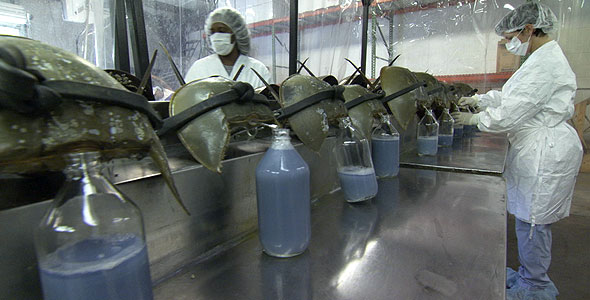A Blue-Blooded Solution
You’re not feeling well so you visit the doctor. It turns out that you need some sort of intravenous medicine, so he or she hooks up an IV and starts the meds flowing. Three days later, you’re feeling horrible again, so you return to the doctor. The original problem is gone, but you’ve developed some sort of bacterial infection in your bloodstream in the process, and now require treatment for that. It turns out that the IV drug was tainted with some sort of bacteria.
Medical science wants to avoid such outcomes and in most cases succeeds to doing so — the situation described above is both hypothetical and rare. And for that, you can thank the horseshoe crab.
Bacteria such as E. coli release something called bacterial endotoxins — that’s the stuff which ends up causing infections if it gets into our bodies. Whenever the pharmaceutical industry creates a new drug or implanted device, the U.S. Food and Drug Administration requires that the new product be tested for endotoxins, as we don’t want our medicines making us sicker. Fail the test and you can’t market your product in the United States.
Testing for endotoxins, though, was slow and expensive until about fifty years ago. In the late 1960s, that changed, when researchers discovered that a substance called limulus amebocyte lysate, or LAL, made it easy to find the microscopic bad stuff floating within these newly developed medical solutions. As a PBS report summarizes, LAL “immediately binds and clots around fungi, viruses, and bacterial endotoxins,” allowing for easy recognition of contamination. And in 1970 or 1971, the FDA approved LAL use as a test for such endotoxins. With this new, better test now acceptable, the speed and expense of such testing plummeted shortly thereafter.
So how do we get LAL? From the process depicted below, via that same PBS article.

The blue stuff in those really large glass jars is blood — the blood from the horseshoe crab situated on top of the bottle. Horseshoe crab blood contains LAL (uniquely at that) and LAL is relatively easily extracted from them. We just have to collect the blood, first, which is exactly what’s happening above. The LAL manufacturers literally tap into the crab’s vascular system, taking as much as 30% of the animal’s blood in any one blood-draining session.
LAL manufacturers require about 250,000 horseshoe crabs to provide a year’s supply of LAL. To protect the crab population (and to keep costs down — a dead crab isn’t worth much), manufacturers claim to take blood from a crab only once a year and have only about a 3% horseshoe crab mortality rate. (That number is controversial, though; independent studies put the mortality rate at 15% or even 30%.) The value gained from LAL is widely-regarded as enormous, which is likely why the global market for horseshoe crab blood is roughly $50 million annually, with the blue liquid selling for north of $50,000 per gallon.
The biggest concern going forward? The value of horseshoe crab blood has led to some overfishing, and while populations globally are still extremely plentiful, they’ve noticeably dipped in recent years. A few areas (South Carolina, New Jersey and Delaware most notably) have issued restrictions on their harvesting.
Bonus Fact: Horseshoe crab contains hemocyanin (as opposed to hemoglobin, which us humans have) to carry oxygen through its body. That doesn’t help us when it comes to finding endotoxins, but it does explain why horseshoe crab blood is blue. Hemocyanin uses copper to deliver oxygen throughout the crab’s body. The deoxygenated copper molecules are colorless, but oxygenated ones are blue. (Oh, and if you were ever told that deoxygenated human blood is blue until it hits the air, well, that’s just false.)
From the Archives: The Right to Bleed: Not about horseshoe crabs.
Related: I don’t think this is real (so you can’t get blood from it.)
